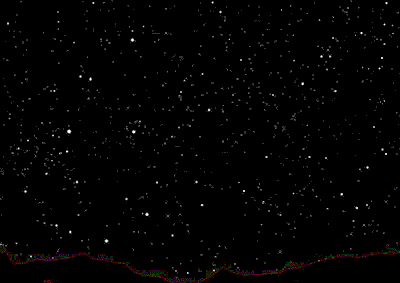Iridium Flares
Posted On January 1, 2000
By Russell Sipe
Get ready folks. It's about to begin. First it will be a UFO report:
"I was looking at the sky when I noticed this light traveling along that got brighter and brighter. I knew it wasn't an airplane because there were no red lights. Just a bright light that got incredibly brighter. It nearly blinded me. It couldn't have been from this world."
We will explain to them that what they saw was an Iridium satellite. Then the government conspiracy theories will start:
"Have you seen those bright flashes in the night sky? The government is radiating us with iridium. It's part of a vast conspiracy to sterilize males and control population growth."
We will tell them that is hogwash. They will respond by quoting a quatrain from Nostradamus in which he predicted these events. When they discover that there are to be 66 of these satellites, they will make the minor jump from 66 to 666 and tell us how the Antichrist is behind it all.
Mark my words.
What's Going On?
While we wait for these events, let's enjoy this brief window of sanity and enjoy, or vilify (depending on your viewpoint) this phenomenon. In the May 1998 issue of Sky & Telescope Philip Chien wrote an excellent primer on Iridium flares. There are also a number of web sites covering the subject. Links are provided at the end of this article.
Beginning May 1997 Motorola began launching a series of communications satellites known by the commercial name Iridium. The satellites have no association with the element iridium beyond the name. Each satellite has three antennae. Each antenna is about the size of a typical door in your home and is is a near perfect mirror. When they are oriented just right a small portion of the earth will receive an nearly perfect reflection of the Sun. A perfect "hit" will produce a flash of 8 magnitude. If the Sun were a door sized object it would shine at a bit more than 8 magnitude. This is bright enough to cause dim shadows on the ground. There are reports that Iridium flares have been visible as glows in thin cloud-covered skies. However the magnitude drop off is rapid. A person at the center of the flash can see a 8 magnitude event while someone twenty miles away will only see a 4 magnitude (equal to Venus in brightness) event. Just using the phrase "only as bright as Venus" to describe a diminished apparition tells you that we are dealing with a new thing in the night sky.

Title photo courtesy of Chris Dorreman Astrographics.
Don't miss the animated flare below.

Show Me The Money
Ed. Note: A new RTMC flare photo from John Sanford is here.
The exciting thing is that these flares can be predicted with amazing accuracy. At the 1998 Riverside Telescope Maker's Conference several predicted flares were observed by hundreds of observers. One, a 7 magnitude event, drew such a huge cheer from the crowd that it could be heard a mile away. Stephen Edberg, an RTMC leader, commented that "hearing" the flares (i.e. the crowd) was nearly as exciting as seeing them. Another flare on the same night only reached 4magnitude but was accented by a bright meteor during it's passage.
Simulation of a -4 magnitude flash from an Iridium satellite and a bright meteor passing through Cygnus as observed at RTMC on May 24, 1998. Animation copyright by Russell Sipe. Background stars from The Sky Level IV by Software Bisque.

The Good, or the Bad and Ugly
On any given night an observer could see a half dozen or more of these flares. Most will be dimmer than the 8 monsters. You can expect to see a 6 magnitude or greater flare once or twice a week if you know where to look.
The flares can be a disruptive element to amateur astronomers conducting wide field astrophotography. The most dedicated photographers will run programs that predict the passage of these objects so as to avoid them. Obviously, most amateur astronomers look upon these satellites as just one more step along the slippery road of increased light pollution.
On the other hand, we have an opportunity here to make lemonade out of lemons. The Star Wars generation has been hard to impress with telescopic views of deep sky objects, and our explanations of the vastness of the universe. They are attune to exploding death stars and celestial dogfights. Their WOW factor is set very high. Getting them to come to a dark sky site to get wowed at the eyepiece is very difficult.
Fortunately astronomers have had a couple big wowsers in the last few years that have attracted the interest of the public. First it was Shoemaker-Levy-9's title bout with Jupiter. Then it was the Comet Hale-Bopp media tour. And the Hubble Space Telescope chimes in every six months or so with some incredible photo that makes the network rounds. So the one time big events have been there.
Now, with Iridium flashes, there is an ongoing predictable wowser than can serve as a trojan horse to lure unsuspecting light pollution dwellers into the dark and majestic world of astronomy. The Iridium satellites could become astronomers unwitting partners in building an interest in the night sky if they will seize the day, or should I say seize the night.

Become an expert in these objects. Learn how to predict their passage. Wow your friends. And tickle the interest of a potential new amateur astronomer. Or, depending on your personality, you could also predict the next UFO/government iridium flash over your boss's house.
Some Links for Iridium Satellite Information
Catch a Flaring/Glinting Iridium
The basic Iridium information can be found here. You will also find links to the shareware programs used to predict satellite passes.
The Iridium Satellite Network
The Iridium system is explained at the Iridium company web site.
Celestrak
Celestrak provides the two-element sets for the Iridium (and many other) satellites
GSOC Satellite Predictions
This is a web-based satellite prediction program.
Iridium Flare Videos
Uwe Reimann is building a site containing Iridium flash videos.
Views: 7